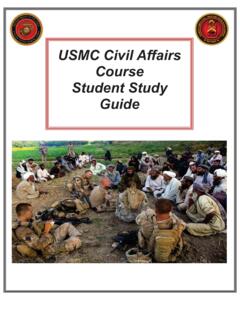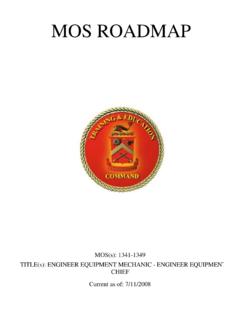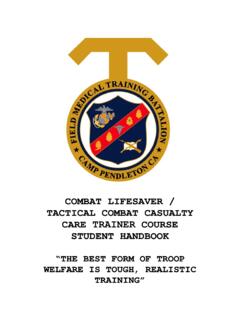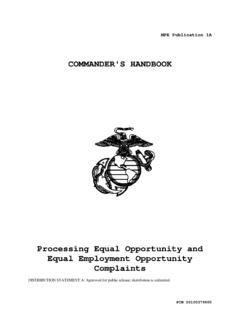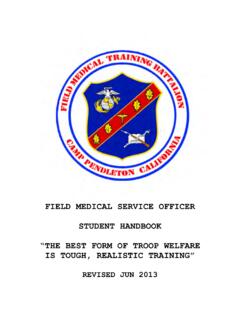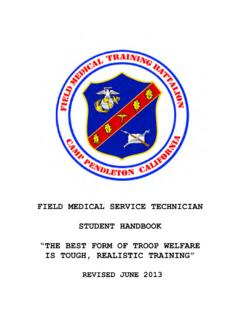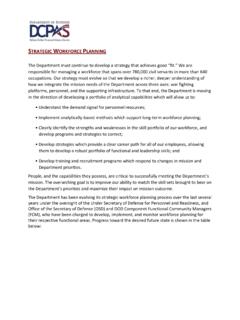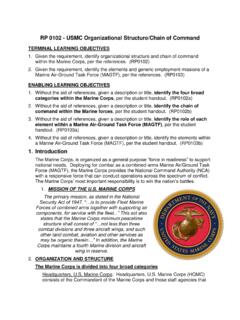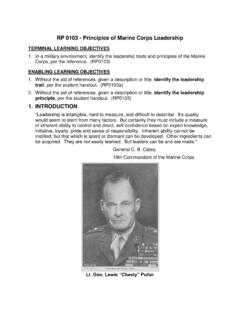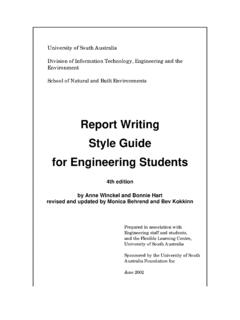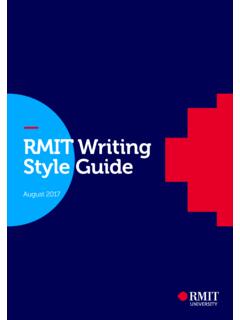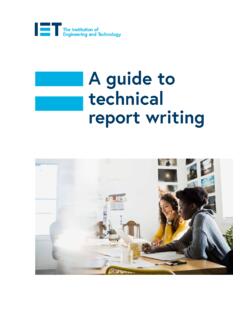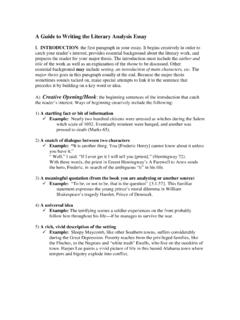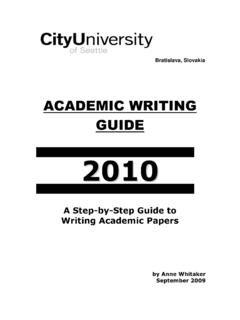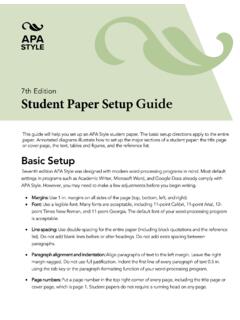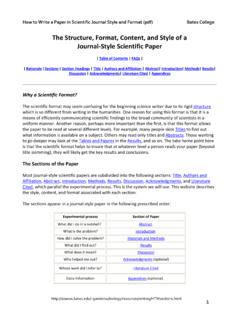Transcription of COMMUNICATIONS STYLE GUIDE - United States Marine …
1 COMMUNICATIONS STYLE GUIDE Fifth Edition A PUBLICATION OF THE LEADERSHIP COMMUNICATION SKILLS CENTER Marine CORPS UNIVERSITY Academic Year 2012 ii iii Marine Corps University COMMUNICATIONS STYLE GUIDE Marine Corps University Quantico, VA iv Table of Contents Foreword xii Preface xiii Leadership Communication Skills Center xv Operating Procedures xv Acknowledgements xvii Chapter 1: Communication A Leadership Skill 1 Communication and Leadership 1 Oral Communication versus Written Communication 1 Taking Your writing Beyond the Classroom 1 writing : More than an Academic Exercise 2 So What? 3 Introduction to the writing Process 4 Chapter 2: Preparing to Write 5 Deciding on and Planning Your Purpose 5 Analyzing Your Audience 6 Audience Analysis Worksheet 7 Approaching Assignments 8 Identify the Key Words 8 Determine the Scope of the Assignment 10 Critical Reading 11 Critical Reading Worksheet 15 Chapter 3: Preparing to Write a Research Paper 17 What is a Research Paper?
2 17 Report Paper vs. Research Paper 18 What is Research? 18 Approaching Research Systematically 19 Taking a Second Look: Revisiting Your Thesis 20 Chapter 4: Choosing a Topic and 22 Developing a Research Question 22 Strategies for Choosing a Topic 22 I Have a Topic, Now What? 23 v Developing a Research Question 23 Reviewing the Literature on Your Topic 23 Evaluating Your Sources 25 Assessing the credibility of an argument: 27 Begin to Formulate Your Working Thesis Statement 28 Chapter 5: Narrowing the Focus 29 What is a Thesis Statement? 29 The Importance of Argument 29 Make it Fresh 30 How do I Begin Constructing my Working Thesis Statement? 31 Using Research Questions to Formulate Thesis Statements 31 Common Problems in Argumentative Thesis writing 33 Chapter 6: Research Methodology and Data Collection 36 Choosing a Research Design (Methodology) for your Paper 36 Quantitative versus Qualitative Research 36 Qualitative Research Designs 38 Historical Research 39 Using Primary and Secondary Sources in Academic writing 40 Primary Sources 40 Evaluating the Veracity (Truthfulness) of Texts 41 Secondary Sources 42 Varying your Sources 43 Constructing Interview and Survey Questions 44 Open-ended versus Close-ended Questions 46 Mistakes to Avoid When Constructing Interview and Survey Questions 46 Conducting Surveys 47 Conducting Interviews.
3 Basic Guidelines 47 Note-taking/Organizing Your Data 48 Analyzing Data 51 Additional Resources 51 Chapter 7: Using Citations to Avoid Plagiarism 53 When Do You Need to Use a Citation? 53 What is Plagiarism? 54 vi Three Main Types of Plagiarism 54 Avoiding Plagiarism 55 Strategies for Avoiding Plagiarism 55 Using Direct Quotations 56 Paraphrase 57 Summary 58 Using Your Sources Effectively 58 Paraphrasing and Quoting: Frequently Asked Questions 59 Editing Quotations and Integrating Quotes into your text 60 Citing a Source Quoted in Another Source: 63 Books 65 Book with One Author 65 Book with Two Authors 66 Book with Three Authors 66 Book with Four to Ten Authors 66 Book with a Corporate Author 67 Book with an Editor(s) 67 Book with an Author and Editor and/or Translator 67 Non- English Language Source 68 Book with Edition 68 Article in an Edited Book 69 Book with Multiple Volumes 69 Reprint 69 Contribution to a Multi-author Book 70 One Volume of a Multi-volume Work with Different Authors 70 One Volume of a Multi-volume Work with Multiple Parts 71 Books Available Online 71 Publisher s Imprint 72 Letter in a Published Collection 72 Pamphlets and Reports 72 E-book 73 Congressional Research Service (CRS)
4 Reports 74 Print 74 vii CRS Reports Retrieved from Electronic Databases such as EBSCO or STINET 74 CRS Reports Available Online 74 Government Publications 75 Congressional Hearings in Print 75 Executive Department Documents (Reports, Bulletins, Circulars) 75 Committee Prints 76 Commission Reports 76 Government Documents Available in Electronic Databases such as STINET or LexisNexis 77 Presidential Documents 77 Government Documents Available Online 78 Laws and Statutes 78 Interviews 79 Unpublished Interviews and Personal COMMUNICATIONS 79 Published or Broadcast Interviews 79 Published or Broadcast Interviews Retrieved from Electronic Databases 79 Published or Broadcast Interview Available Online 80 Unattributed Interviews 81 Audio and Visual Sources 82 DVD or Video 82 Lecture or Presentation 82 Journal Articles 83 Journal Articles in Print 83 Journal Articles from Electronic Databases such as ProQuest, JSTOR.
5 And EBSCO 83 Journal Articles from an Online Journal 84 Foreign Language Articles and Journals 84 Translated Article 85 Magazine Articles 86 Magazine Articles in Print 86 Magazine Articles from Electronic Databases such as ProQuest, EBSCO, and LexisNexis 86 Magazine Articles from an Online Magazine 87 Military Publications 88 Doctrinal Publications 88 Directives 88 viii Instructions 88 Orders 89 Marine Corps Bulletins (MCBuls) 89 Student Thesis 90 Student Thesis in Print 90 Student Thesis Retrieved from Electronic Databases 90 Unpublished Paper 91 Working Papers and Drafts 91 MCU Handouts 91 Reference Materials (Dictionaries and Encyclopedias) 92 Print 92 Dictionaries and Encyclopedias Available Online 92 Newspaper Articles 93 Newspaper Articles in Print 93 Newspaper Articles from Electronic Databases such as ProQuest, EBSCO, and LexisNexis 94 Newspaper Articles from an Online Newspaper AND News Sites 95 Archives and Special Collections 96 Correspondence 96 Reports 96 Photographs 97 Oral Histories 97 Films 98 Maps 98 Sound Recording 99 Web Sites and Postings 100 Online Posting 100 Web Site 100 Electronic Mailing Lists 100 Chapter 8.
6 Prewriting 101 Brainstorming/Overcoming Writer s Block 101 Strategies to get started 101 Concept Mapping 107 Formulating an Outline 108 ix Types of Organization Methods 109 writing Your Thesis Proposal 113 Thesis Statement Proposal Form 114 Learning styles 116 Parts of the Paper 118 The Introduction 118 Constructing Supporting Paragraphs 127 writing the Conclusion 129 Chapter 10: Mechanics and Grammar of writing 131 Punctuation 131 The Comma 131 The Semicolon 134 The Colon 135 The Dash 137 The Hyphen 137 Parentheses 138 Mechanics 139 Italics 139 Abbreviations 140 Capitalization 141 Numerals 145 Grammar 147 Possessive Nouns 147 Pronouns 149 Coordinating Conjunctions 152 Parallelism 152 STYLE 153 Active Voice vs. Passive Voice 153 Point of View/Voice: First Person, Second Person, or Third Person?
7 154 Chapter 11: Revising, Editing, and Proofreading 155 What Should I Check for When I Revise my Paper? 155 The First Revision: Logic, Content, Organization, Headings, and Documentation 155 Using Transitions 157 x Headings 159 Reevaluating Research/Supporting Evidence 160 The Second Revision: Word Choice, Clarity, and Verbosity 160 Evaluating Your Word Choice: Tricks of the Wordsmith s Trade 160 Clarity 161 Avoid Verbosity/Eliminate Fluff 163 Vary Sentence Length and Structure 163 The Third Revision: Diction and Tone 164 Diction 164 Tone 164 The Final Step in the writing Process: Proofreading 164 Proofreading Strategies 165 Paper Order 165 Resources for Additional Help 167 Chapter 12: Using Visuals 168 When to Use Visuals 168 How to Create an Effective Visual 168 Important components of effective visuals 168 Types of Visuals: When to Use Them 169 Chapter 13, Part 1: Listening 174 Listening in Organizations 174 Hearing vs.
8 Listening 174 Listening in the Classroom vs. in the Workplace 174 Types of Listening 174 Chapter 13, Part 2: Developing Oral Presentations 177 How do Spoken and Written COMMUNICATIONS Differ? 177 Self-Evaluation of Current Presentation Skills 177 Process of Creating an Oral Presentation: Three Steps 178 Step 1: Plan Your Presentation 178 Step 2: Write Your Presentation 179 Step 3: Polish Your Presentation 182 Strategies for Dealing with Nervousness 182 Appropriate Body Language 183 xi Use Effective Non-Verbal Communication during the Presentation 183 Using Notes during Your Presentation 183 Question and Answer Session 183 During The Question and Answer Session 185 Group Presentations 185 How to Organize a Group Presentation 185 Chapter 13, Part 3: Participating in Seminar Discussions 187 Characteristics of Effective Seminar Participants 187 How to Prepare for Active Classroom Participation.
9 Before Class 187 Appendix A 189 Article Submission Guidelines for Selected Military Periodicals 189 Military Essay Contests 191 Appendix B 193 writing Assignment Grading Rubric for MCWAR, CSC, SAW 193 Oral Presentation Grading Rubric for MCWAR, CSC, SAW 194 Student Participation in Seminar Discussion Rubric 195 Appendix C 196 Guidelines for Chicago Manual of STYLE 196 Glossary of Grammatical Terms 199 Glossary of Commonly confused words and word pairs 203 Appendix E 206 Bibliography 208 xii Foreword As students at Marine Corps University (MCU), and as officers and enlisted members of the United States Armed Forces, effective communication has never been more important in one s professional military education. Improving your communication skills in order to brief, instruct, persuade, counsel, and motivate fellow service members is paramount.
10 I believe the Marine Corps University COMMUNICATIONS Syle GUIDE will be an asset to both you as a student and to the University; first, because it establishes a uniform STYLE of writing across the University s schools; and second, because it provides students with a one-stop resource for research methodology and written and verbal COMMUNICATIONS guidelines. The informal GUIDE provides MCU students with a user-friendly reference that contains much of the information needed to write academic and military- STYLE papers, conduct scholarly research, and communicate effectively. In keeping with the Marine Corps initiative to go green, and in an effort to make the GUIDE more interactive, the Academic Year 2012 MCU COMMUNICATIONS STYLE GUIDE is also available online (on both MCU s and the Gray Research Center s homepages).
